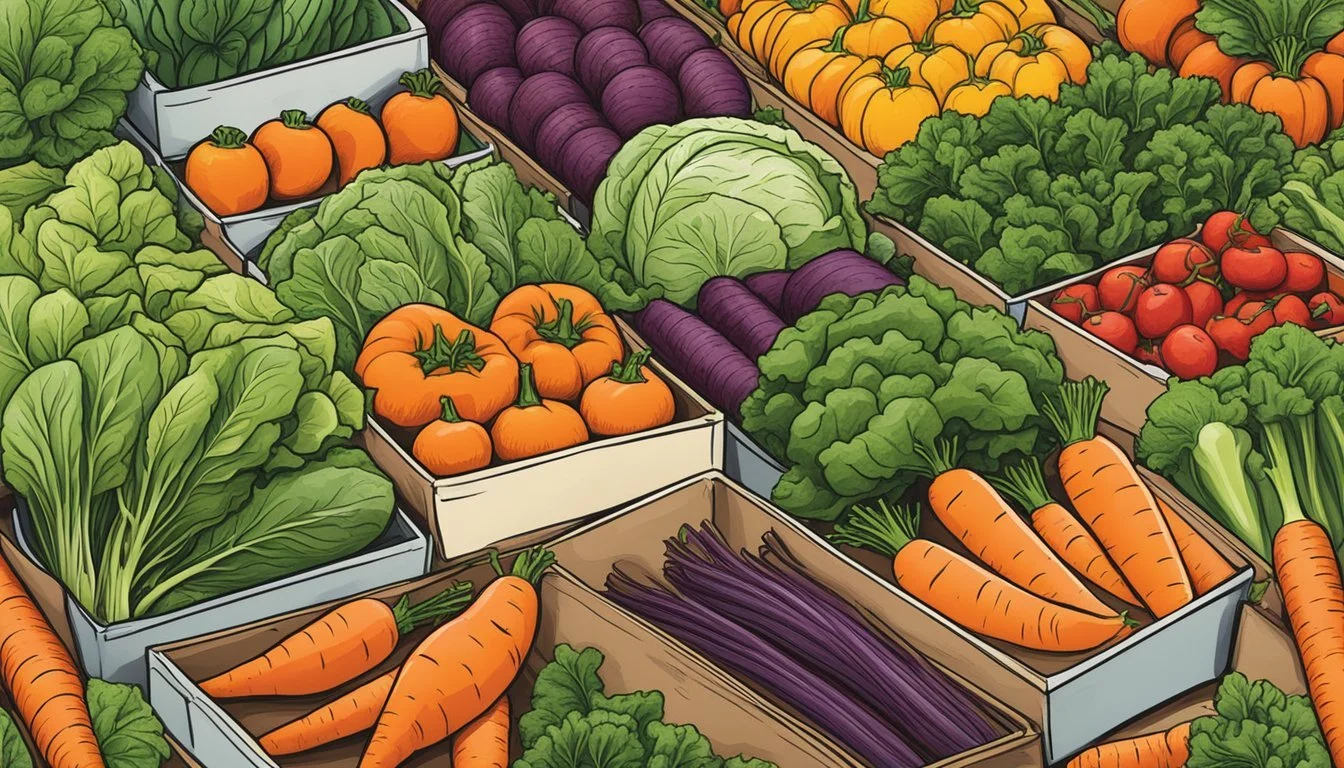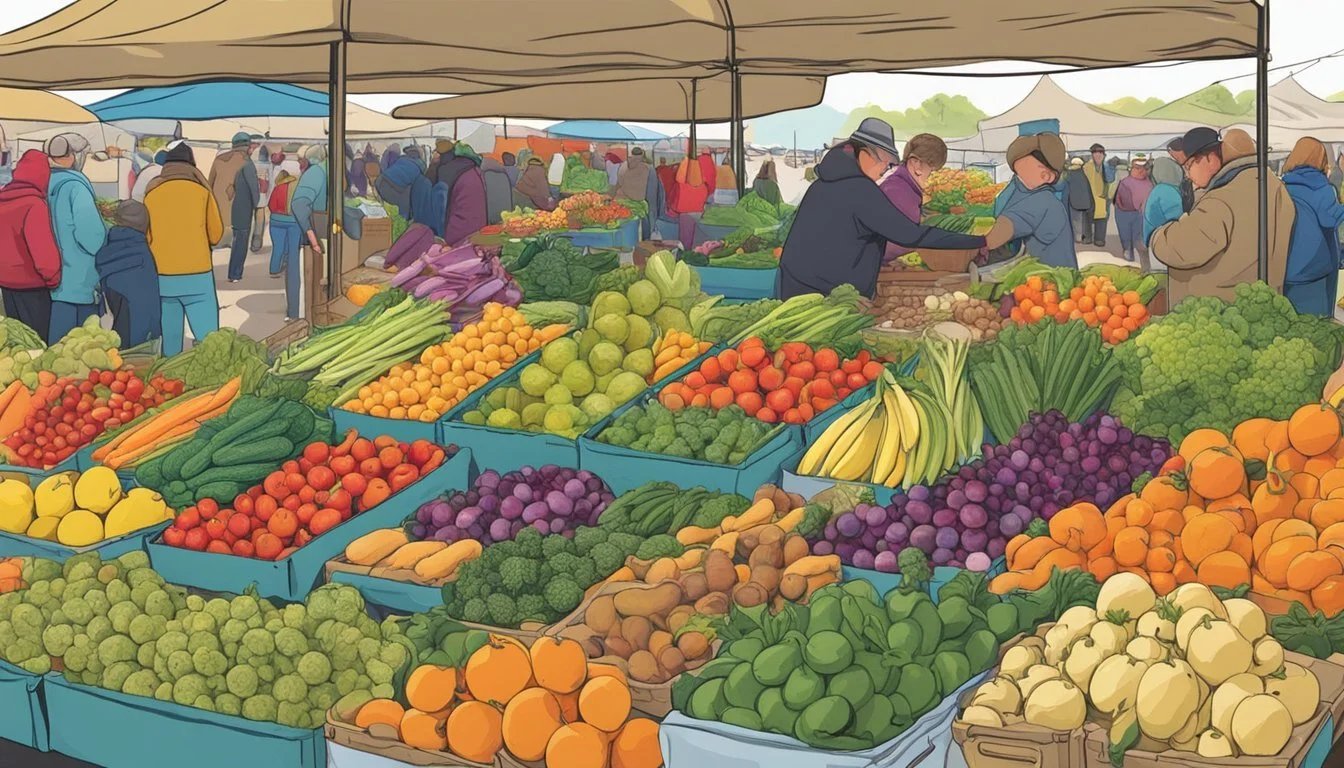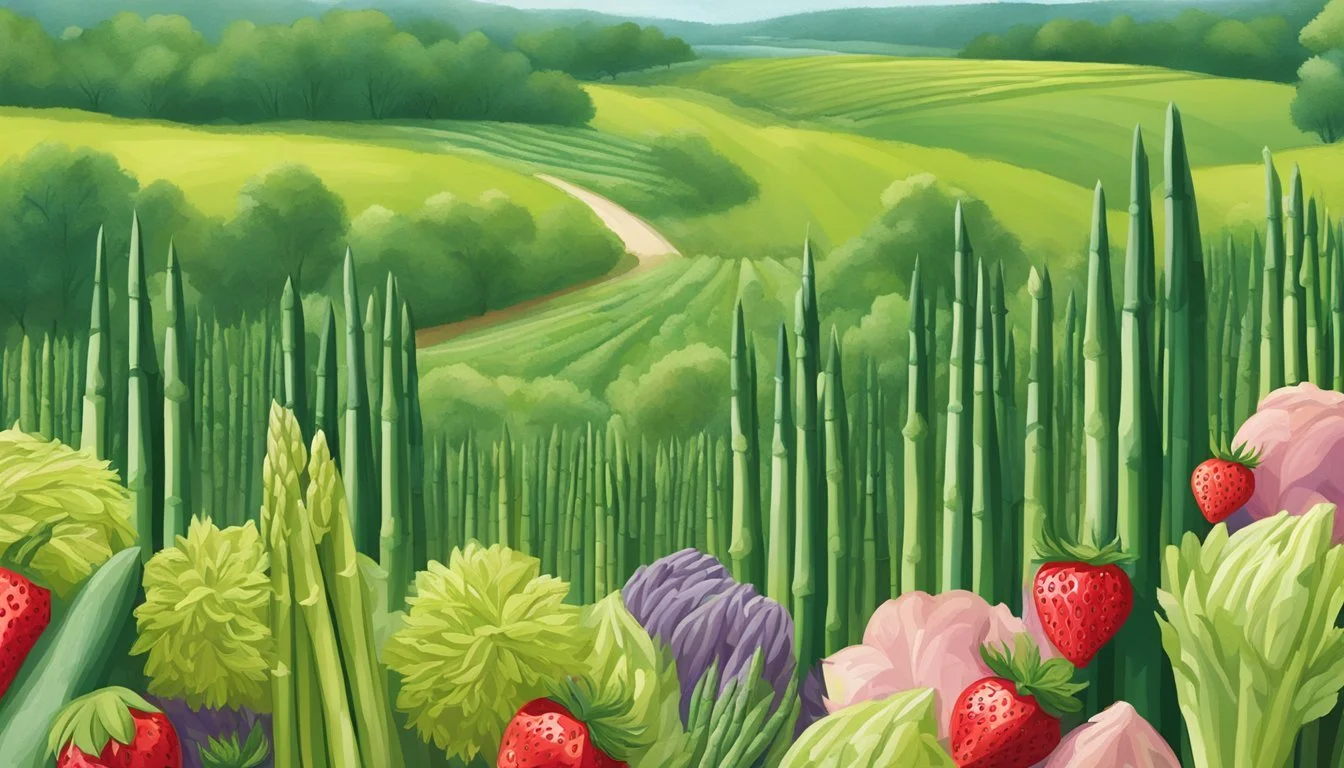Nebraska Seasonal Fruit & Vegetables in March
Your Guide to Fresh Produce
This Article is Part of our Nebraska Seasonal Fruit & Veg Calendar
In Nebraska, the arrival of March signals a transition period in the agricultural calendar as winter thaws and spring promises new growth. Seasonal produce begins to shift, and consumers eager for fresh fruits and vegetables start to see changes in availability. During this month, farmers prepare for the planting season, and the earliest crops start to make their way to market.
Though March is not peak season for fruit harvests in Nebraska, it is a time when the groundwork is laid for the lush months ahead. Vegetables that thrive in cooler temperatures, such as spinach (What wine goes well with spinach?) and radishes, may begin to appear at local markets, their growth favored by the milder late-winter climate. They often stand alongside stored produce from the previous year's harvest, such as winter squash and onions, which remain staples until the new season's bounty becomes more abundant.
The focus on seasonal produce during this period encourages local consumption and supports the state's agricultural economy. Nebraska residents are provided with an opportunity to engage with their local food systems by purchasing what is grown in their own state. As the days lengthen and the soil warms, anticipation for a wider variety of fresh, locally grown produce fuels the markets and the local community's appetite for wholesome, nutritious offerings.
Seasonal Overview
March marks the transition from winter's dormancy to the burgeoning growth of spring in Nebraska's agricultural landscape. This shift has significant implications for the availability of fresh produce in the state.
Understanding Seasonality
Seasonality refers to the time of year when fruits and vegetables are at their peak in terms of flavor and nutritional content. In Nebraska, as in many regions, this is closely tied to the natural growing cycles influenced by local climate conditions. As winter eases into spring, a new array of produce becomes available.
Winter: The tail end of the cold season, with limited fresh options.
Spring: A period of renewal where early-season crops begin to flourish.
March in Nebraska
In Nebraska, the month of March is a period of transformation within the agricultural sector. The state begins to shed its winter chill, laying the groundwork for spring plantings and the first harvests of the year. Residents and chefs alike anticipate the arrival of the following:
Vegetables:
Asparagus (What wine goes well with asparagus?)
Spinach
Lettuce
Radishes
Fruits: While the fruit selection is still growing, some storage apples and greenhouse produce may be available.
The availability of these items can signify the state's move towards a more diverse and robust array of fresh produce. As the weeks progress, these selections will expand, further highlighting the importance of understanding and utilizing seasonal produce in Nebraska.
Fruits in Season
In March, Nebraska offers a refreshing variety of fruits, including several citrus options rich in vitamin C, an array of exotic fruits, and a selection of crisp pome and stone fruits.
Citrus Varieties
March is a stellar month for citrus fruit, which remains in peak season. Consumers can enjoy a range of citrus fruits noted for their zesty flavor and high vitamin C content. Some readily available citrus options in Nebraska include:
Oranges: Sweet and juicy, perfect for a snack or fresh juice.
Grapefruits: Slightly tart, these fruits offer a zingy start to the day.
Exotic Fruits Available
Exotic fruits make a colorful entrance in March, with stores and markets often stocking these tropical delights:
Pineapples: Their sweet and tangy taste brings a tropical flair to Nebraska tables.
Kiwi: A small fruit with a unique, tangy flavor and a soft, edible skin.
Pome and Stone Fruits
Though pome and stone fruits are not as abundant as citrus and exotic varieties during early spring, there are still options available:
Apples: They retain their firmness and sweet-tart flavor profile; perfect for pies and salads.
Pears: Depending on variety, pears can range from buttery and soft to crisp and refreshing.
Vegetables and Greens
In March, Nebraska's landscape begins to yield a fresh assortment of vegetables and greens, offering a variety of flavors and nutritional profiles. Farmers and home gardeners start to see the first signs of spring produce.
Leafy Greens
Leafy greens thrive in the cool temperatures of early spring in Nebraska. Kale, a hardy green rich in vitamins, is robust during this time. Lettuce varieties such as Romaine and butterhead are also common, providing the base for fresh spring salads. Arugula, with its peppery flavor, complements the milder tastes of other greens and is eagerly harvested in March.
Root Vegetables
While some root vegetables are stored from winter, others begin to make their appearance in March. Radishes, quick to mature, add a crisp, peppery accent to dishes. Gardeners often harvest tender carrots, which can be sown in Nebraska as early as the soil can be worked. Beets, earthy and rich, also start becoming available and can be roasted, boiled, or eaten raw.
Cruciferous Vegetables
Nebraska's March conditions are conducive to growing a variety of cruciferous vegetables. Broccoli (how long does broccoli last?)starts becoming available, offering both flavor and health benefits in early spring dishes. These vegetables are known for their characteristic pungent flavors and nutrition-packed florets.
Buying and Selecting
When selecting fruits and vegetables in Nebraska during March, shoppers should consider the best places to purchase produce for optimal freshness and variety. They can approach farmers' markets for locally-grown options or grocery stores for a wider range. Observing freshness indicators ensures the produce is at peak quality.
Farmers' Markets
At Nebraska farmers' markets, one can find an array of seasonal produce directly from local farmers. They should look for markets that offer a diverse selection of March seasonal items such as spinach, kale, and radishes. Buyers are encouraged to engage with farmers, as this can yield information about the growing practices and peak harvest times.
Grocery Store Tips
When shopping at grocery stores, consumers should seek out sections dedicated to local produce. Many stores now highlight fruits and vegetables sourced from nearby regions. Look for signs indicating the produce is “Nebraska-grown” or “local” to ensure freshness and support regional agriculture.
Freshness Indicators
To determine the freshness of raw produce, shoppers should examine the texture, color, and aroma:
Texture: Fruits should be firm but yield slightly to pressure; vegetables should be crisp.
Color: Look for vibrant, natural colors indicative of ripeness and freshness; avoid items with discoloration or bruising.
Aroma: Ripe fruits often emit a fresh, sweet scent; vegetables should have a clean, earthy smell.
Preparation and Storage
When dealing with seasonal produce in Nebraska during March, understanding optimal storage techniques and preparation methods is essential. This ensures not only the longevity of the fruits and vegetables but also the best flavor and nutrient retention when cooked or consumed.
Storing for Freshness
Fruits: Most fruits should be stored in the refrigerator to maintain freshness. Hardy fruits such as apples can be kept for a longer period compared to berries, which should be consumed more quickly due to their delicate nature.
Apples: Keep in a cool, humid area, preferably in a plastic bag with holes for ventilation.
Berries: Store in a shallow container in the refrigerator and rinse just before use.
Vegetables: Vegetables require varying storage methods depending on their type. Most green leafy vegetables prefer a cold and moist environment, while root vegetables like turnips can be stored in a cool, dark place.
Leafy Greens: Wrap in a damp cloth and place in the crisper drawer of the refrigerator.
Root Vegetables: Store in a cool, dark place with good ventilation. They can last for weeks when stored properly.
Preparation Techniques
Before consuming or cooking, all produce should be thoroughly washed to remove dirt and potential residues. Different preparation techniques can be employed to enhance the flavors and textures of March's seasonal produce in Nebraska.
Roasting: Toss root vegetables such as turnips with olive oil and roast until tender to bring out a natural sweetness. A sprinkle of flaky salt can enhance the flavor.
Salads: Use fresh greens as the foundation for a vibrant salad. Incorporate seasonal fruits like apples for a sweet crunch.
Blanch: Some vegetables can be blanched to retain color and nutrients before being used in recipes or served with a drizzle of olive oil.
By storing fruits and vegetables properly for their freshness and knowing various preparation techniques, individuals can fully enjoy Nebraska's March seasonal produce to its fullest potential.
Cooking and Recipes
March in Nebraska brings a delightful array of seasonal produce that can transform one's cooking repertoire. The focus is on incorporating these fresh ingredients into savory dishes, sweet treats, and vibrant salads.
Savory Dishes
Nebraska's seasonal produce such as spinach and sweet potatoes (What wine goes well with sweet potatoes?) can be the cornerstone of hearty savory recipes. One can steam broccoli and pair it with a succulent chicken breast for a nutrient-rich meal. Alternatively, tossing asparagus with pasta and a garlic-infused olive oil can create a simple yet satisfying dish.
Steamed Broccoli and Chicken
Nutrients: Rich in vitamins and protein
Method: Steam broccoli, sauté chicken, and combine
Ingredients: Asparagus, pasta, garlic, olive oil
Technique: Sauté asparagus and garlic, toss with cooked pasta
Sweet Treats
Sweet potatoes can be more than just a savory staple; they shine in sweet recipes as well. One might bake them into a pie or mash them for a delightful sweet potato casserole topped with a crisp, nutty streusel.
Sweet Potato Pie
Flavor Profile: Earthy sweetness enhanced by warm spices
Key Steps: Mash cooked sweet potatoes, blend with spices, bake in pie crust
Sweet Potato Casserole
Textures: Soft base with a crunchy topping
Suggestion: Add a streusel made of nuts (how long do nuts last?) for an extra layer of texture
Salad Creations
Salads in March can feature the crispness of shaved Brussels sprouts (how long do brussels sprouts last?) or the freshness of spinach. Simple homemade dressings, such as a citrus vinaigrette, complement the salads without overshadowing the natural flavors of the vegetables.
Shaved Brussels Sprout Salad
Preparation: Shave Brussels sprouts thinly, add a tangy dressing
Dressing Options: Citrus vinaigrette or light mustard dressing
Spinach Salad
Variations: Incorporate hard-boiled eggs, nuts, or even fresh berries as they come into season
Benefits: High in iron and other essential nutrients
The ingredients and the methods provided here can inspire one's cooking during the transitioning season, where the end of winter meets the beginning of spring's bounty.
Health and Nutrition
In March, consumers can reap the benefits of seasonal produce in Nebraska by enjoying fresh vegetables and fruits that are not only packed with essential nutrients but also offer enhanced flavor. This bounty is typically richer in vitamins and minerals due to the peak natural ripeness at the time of harvest.
Nutritional Value
Seasonal fruits and vegetables harvested in March often provide substantial nutritional value. They tend to contain higher levels of vitamins and minerals compared to out-of-season produce. For instance, fresh vegetables like spinach and kale are readily available and are good sources of Vitamin K, iron, and calcium. Nutrient-dense fruits such as strawberries start to come into season, offering a rich source of Vitamin C, fiber, and antioxidants.
Vitamin C: Crucial for the growth and repair of all body tissues, boosting the immune system, and aiding in iron absorption.
Iron: Vital for blood production and oxygen transport throughout the body.
Calcium: Essential for bone health and maintaining the necessary level of bone mass.
Dietary Considerations
When focusing on dietary considerations, it's important to recognize the balance and variety offered by seasonal produce. Including a wide array of colorful fruits and vegetables in one's diet ensures a comprehensive intake of essential nutrients. People considering their dietary needs in March should take advantage of the abundance of fresh vegetables like broccoli and Brussels sprouts, which can support a healthy diet.
Broccoli: A great source of fiber, Vitamin C, and compounds that may support healthy cellular function.
Brussels Sprouts: They are high in fiber, vitamins, minerals, and antioxidants, potentially reducing the risk of chronic diseases.
Choosing seasonal produce not only provides a superior taste and cost savings but ensures that the body receives high-quality nutrients necessary for good health and nutrition. Fresh vegetables and fruits that are in season typically retain more of their nutritional content, making them a healthier choice for consumers.
Agricultural Practices
In Nebraska, March marks a transitional period in agricultural practices with an emphasis on sustainable approaches and the strategic use of crop rotation to enhance soil health and combat disease.
Sustainable Farming
Farmers in Nebraska integrate sustainable farming methods to bolster ecosystem services while also aiming to satisfy human needs. They employ techniques such as cover cropping and conservation tillage to maintain soil integrity and reduce erosion. Water conservation measures are critical, especially as they prepare for the upcoming planting season. Practices such as the use of drip irrigation systems demonstrate their commitment to using resources responsibly. In an effort to curtail disease and promote biodiversity, Nebraska farmers often participate in programs supported by the Department of Agriculture of the United States which emphasize sustainable agriculture.
Crop Rotation Impact
Crop rotation plays a pivotal role in Nebraska's agricultural practices, especially in the month of March. This practice aids in disrupting disease cycles and reducing the dependency on chemical pesticides. By rotating crops, farmers can:
Prevent soil depletion: Alternating crops helps in maintaining the fertility of the soil.
Manage pests and diseases: Certain crops can naturally repel pests or break the cycle of crop-specific diseases.
Moreover, crop rotation supports the balance between different agricultural demands and ecological health, contributing significantly to the long-term sustainability of farming in Nebraska. This agricultural strategy has economic benefits too, as it can lead to improved yield and reduced need for synthetic inputs.
Seasonal Eating Calendar
The calendar for Nebraska's produce in March indicates a transition from winter storage crops to the early offerings of spring. Shoppers can find an array of vegetables and some fruits that are fresh and at peak flavor during this month.
Spring Selections
Vegetables:
Spinach
Peas
Radishes
These green vegetables are among the first to appear in the spring, offering fresh flavors and nutrients after the winter months.
Fruits:
Apples (from cold storage)
While fresh fruit selections are limited, stored apples remain crisp and can be a sweet treat that continues from winter through March.
Monthly Diversities
March offers a glimpse into the changing seasons, with some winter produce still available and the earliest spring crops starting to make their appearance.
Still Available from February:
Cabbages
Carrots
Potatoes
Onions
These storage crops from February remain good choices for hearty meals.
Preparing for August and October: Farmers are beginning the sowing and groundwork in March for crops that will be harvested in the late summer and autumn months, such as:
Tomatoes (for August)
Pumpkins (for October)
While not yet available to eat, these plants start their journey in March, setting the stage for the abundance of produce to come later in the year.









